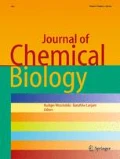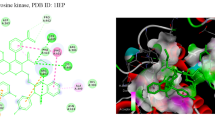Abstract
A series of novel 2-(chromon-3-yl)-4,5-diphenyl-1H-imidazoles (4a-h) were synthesized by one pot condensation of substituted 3-formylchromones (1a-h), benzil (2) and ammonium acetate (3) in refluxing acetic acid at 110 °C under N2 atmosphere. Allylation of compounds 4a-h with allyl bromide in the presence of fused K2CO3 furnished N-allyl-2-(chromon-3-yl)-4,5-diphenyl-1H-imidazoles (6a-h). The synthesized compounds were characterized spectroscopically and evaluated for in vitro antimicrobial activity against various pathogenic bacterial and fungal strains by disc diffusion method. Compounds bearing electron withdrawing substituents such as bromo (4f) showed significant inhibitory activity against S. cerevisiae (MIC 1.4 μg/ml) and 4g containing chloro substituent, displayed more inhibitory potential against C. albicans (MIC 1.5), as compared to the standard drugs. Compounds 6a and 4c exhibit remarkable inhibitory potential against B. subtilis with MIC 0.98 and 1.23, respectively. The time kill assay for active compound 6a was performed by viable cell count (VCC) method to elucidate the microbicidal nature of 2-(chromon-3-yl)imidazoles. A molecular docking study of most active compounds with target ‘lanosterol 14α-demethylase’ (CYP51) was performed to unravel the mode of antifungal action.




Similar content being viewed by others
References
Smith HJ (2006) Introduction to the principles of drug design and action. fourth ed. Taylor Francis,Boca Raton, pp 567−614
Goodman LS, Gilman AG (2001) The pharmacological basis of therapeutic, tenth ed. McGraw-Hill, New York, Sec. VIII, pp 1141–1310
Laura G, Marinella R, Daniela P (2007) Quinones: a class of potential selective antitumor agents. Mini Rev Med Chem 7:481−489
Mascaretti OA (2003) Bacteria versus antibacterial agents: an integrated approach, ASM Press, Washington, p 321
Bakavoli M, Nikapour M, Rahimizadeh M, Saberi MR, Sadeghian H (2007) Design and synthesis of pyrimido[4,5-b][1,4]benzothiazine derivatives, as potent 15-lipoxygenase inhibitors. Bioorg Med Chem 15:2120−2126
Misono M (2001) Unique acid catalysis of heteropoly compounds (heteropolyoxometalates) in the solid state. Chem Commun 1141−1152.
Black JW, Durant GJ, Emmett JC, Ganellin CR (1974) Sulphur-methylene isosterism in the developent of metiamide, a new histamine H2-receptor antagonist. Nature 248:65−67
Antolini M, Bozzoli A, Ghiron C, Kennedy G, Rossi T, Ursini A (1999) Analogues of 4,5-bis(3,5-dichlorophenyl)-2-trifluoromethyl-1H-imidazole as potential antibacterial agents. Bioorg Med Chem Lett 9:1023−1028
Ucucu U, Karaburun NG, Iskdag II (2001) Synthesis and analgesic activity of some 1-benzyl-2-substituted-4,5-diphenyl-1H-imidazole derivatives. Farmaco 56: 285−290
Kathiravan MK, Salake AB, Chothe AS, Dudhe PB, Watode RP, Mukta MS, Gadhwe S (2012) The biology and chemistry of antifungal agents: A review. Bioorg Med Chem 20:5678−5698
Raj T, Bhatia RK, Sharma RK, Gupta V, Sharma D, Ishar MPS. (2009) Mechanism of unusual formation of 3-(5-phenyl-3H-[1,2,4]dithiazol-3-yl)chromen-4-ones and 4-oxo-4H-chromene-3-carbothioic acid N-phenylamides and their antimicrobial evaluation. Eur J Med Chem 22:3209−3216
Mohan H (2010) Medicinal chemistry textbook, 10th ed. pp 519−521
Vijesh AM, Isloor AM, Telkar S, Peethambar SK, Rai S, Isloor N (2011) Synthesis, characterization and antimicrobial studies of some new pyrazole incorporated imidazole derivatives. Eur J Med Chem 46:3531−3536
Padmavathi V, kumara CP, Venkatesh BC, Padmaja A (2011) Synthesis and antimicrobial activity of amido linked pyrrolyl and pyrazolyl-oxazoles, thiazoles and imidazoles. Eur J Med Chem 46:5317−5326
Ramachandran R, Rani M, Senthan S, Jeong YT, Kabilan S (2011) Synthesis, spectral, crystal structure and in vitro antimicrobial evaluation of imidazole/benzotriazole substituted piperidin-4-one derivatives. Eur J Med Chem 46:1926−1934.
Turner WB, Aldridge DC (1983) Fungal metabolites–II, Acedamic Press Inc., New York, p 152
Alam S (2004) Synthesis, antibacterial and antifungal activity of some derivatives of 2-phenylchromen-4-one. J Chem Sci 116:325−331
Prakash O, Kumar R, Parkash V (2008) Synthesis and antifungal activity of some new 3-hydroxy-2-(1-phenyl-3-aryl-4-pyrazolyl) chromones. Eur J Med Chem 43:435−440
Raj T, Bhatia RK, Kapur A, Sharma M, Saxena AK, Ishar MPS (2010) Cytotoxic activity of 3-(5-phenyl-3H-[1,2,4]dithiazol-3-yl)chromen-4-ones and 4-oxo-4H-chromene-3-carbothioic acid Nphenylamides. Eur J Med Chem 45:790−794
(a) Wang J, Mason R, Vanderveer D, Feng K, Bu XR (2003) Convenient preparation of a novel class of Imidazo[1,5-a]pyridines: cecisive role by ammonium acetate in chemoselectivity. J Org Chem 68:5415-5418 (b) Ingle VN, Hatzade KM, Taile VS, Gaidhane PK, Kharche ST (2007) Synthesis of O‐β‐d‐glucopyranosides of 7‐hydroxy‐3‐(imidazol‐2‐yl)‐4H‐chromen‐4‐ones. J Carbohydr Chem 26:107−123
Mitic-Ćulafic D, Vukovic-Gacic B, Knezevic-Vukcevic J, Stankovic S (2005) Comparative study on the antibacterial activity of volatiles from sage (Salvia officinalis L.). Arch Biol Sci 57:173−178
Hindler J, Mahon CC, Manuselis G (Eds.) (1995) Textbook of diagnostic micro-biology special antimicrobial susceptibility tests 89
Kaur GJ, Arora DS (2008) Emergence of highly fluoroquinolone-resistant Salmonella enterica serovar Typhi in a community-based fever surveillance from Kolkata. Int J Antimicrob Ag 31:380−399
Arora DS, Onsare JG (2014) In vitro antimicrobial evaluation and phytoconstituents of Moringa oleifera pod husks. Industrial Crops and Prod 52:125−135
(a) Pore VS, Jagtap MA, Agalave SG, Pandey AK, Siddiqi MI, Kumar V, Shukla PK (2012) Synthesis and antifungal activity of 1,5-disubstituted-1,2,3-triazole containing fluconazole analogues. Med Chem Commun 3:484-488. (b) Sagatova AA, Keniya MV, Wilson RK, Sabherwal M, Tyndall JD, Monk, BC (2016) Triazole resistance mediated by mutations of a conserved active site tyrosine in fungal lanosterol 14 alpha-demethylase. Sci Rep 6: 26213−26213
Schrodinger, Schrodinger Release 2015−4: Schrodinger Suite2015 Protein Preparation Wizard, Epik version 2.5, Schrodinger, LLC,New York, NY, 2013; Impact version 6.0, Schrodinger, LLC, NewYork, NY 2015, Prime version 3.3, Schrodinger, LLC, New York, NY, 2015
Jorgensen WL, Maxwell DS, TiradoRives J (1996) Development and testing of the OPLS all-atom force field on conformational energetics and properties of organic liquids. J Am Chem Soc 118:11225−11236
Schrodinger, Schrödinger Release 2015−4: Maestro, version 10.4, Schrödinger, LLC, New York, NY, 2015
Schrödinger, Schrödinger Release 2015−4: LigPrep, version 2.7, Schrödinger, LLC, New York, NY, 2015
Friesner R A, Murphy RB, Repasky MP, Frye LL, Greenwood JR, Halgren TA, Sanschagrin PC, Mainz, DT (2006) Extra precision glide: docking and scoring incorporating a model of hydrophobic enclosure for protein−ligand complexes. J Med Chem. 49:6177−6196
Acknowledgements
We sincerely express our thanks to the University Grant Commission (UGC) for providing support and funds to our university to generate necessary research facilities.
Author information
Authors and Affiliations
Corresponding author
Electronic supplementary material
ESM 1
(DOCX 24 kb)
Rights and permissions
About this article
Cite this article
Sharma, S., Sharma, V., Singh, G. et al. 2-(chromon-3-yl)imidazole derivatives as potential antimicrobial agents: synthesis, biological evaluation and molecular docking studies. J Chem Biol 10, 35–44 (2017). https://doi.org/10.1007/s12154-016-0162-8
Received:
Accepted:
Published:
Issue Date:
DOI: https://doi.org/10.1007/s12154-016-0162-8




